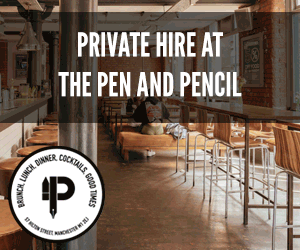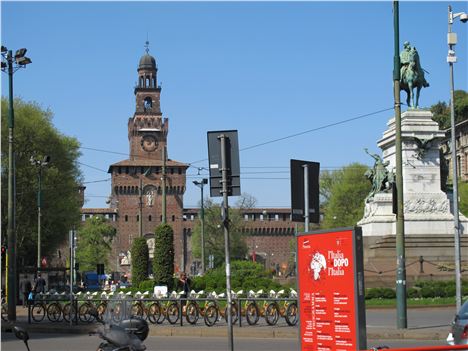HERE are 10 things to see or do in Milan:
1 Duomo – One Mighty Cathedral
They call it the Wedding Cake and it took 500 years in the “baking”. With its 135 spires and 3,500 statues, Europe’s third biggest church (after St Peter’s Rome and Seville Cathedral) looms like a big white Gothic monster across its pigeon-populated piazza. Icing on the cake? Ascend to the roof by lift or stairs and gawp down.
 The Duomo viewed through the windows of the Novocento
The Duomo viewed through the windows of the Novocento
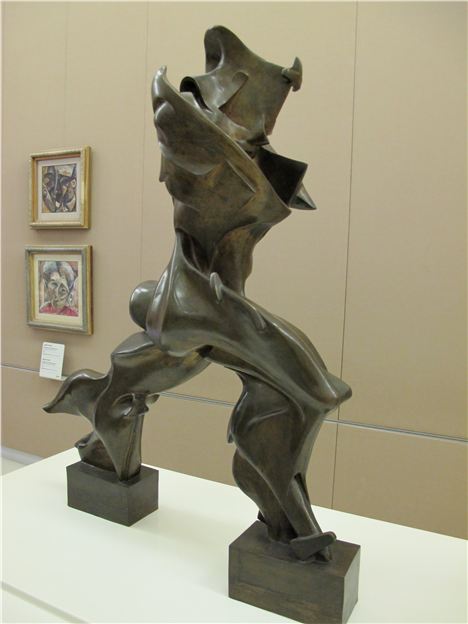 Boccioni's Forme Uniche Della Continuita Nello Spazio in the Museo del Novocento
Boccioni's Forme Uniche Della Continuita Nello Spazio in the Museo del Novocento
2 Museo del Novocento
The Duomo is seen from a whole new perspective from this newcomer among the city’s impressive array of art galleries. It’s a cunning conversion of an existing palazzo dating back to Mussolini times and much of its primarily 20th century art mirrors that turbulent era. More contemporary stuff is found in the Triennale Bovisa, part of the Triennale di Milano design museum. If you find the Novoento’s collection hard-going (I did), linger over cocktails in its Giorgio Arengario Bar for that special view.
3 Eataly Slowfood Store
The Novecento has a cool restaurant, too, but if you are in that area and a foodie it’s more essential to check out Peck. This century-old, multi-floored but compact foodstore is a well-stocked delight from its basement wine cellar to its retro cafe on the top floor. Giving Peck a run for its money is Eatitaly, 10 minutes’ walk away in the Piazza Cinque Giornate. This glossy temple of the Slowfood movement is downstairs in the designer fashion store Coin and stocks some awesome Ligurian olive oil among many delights.
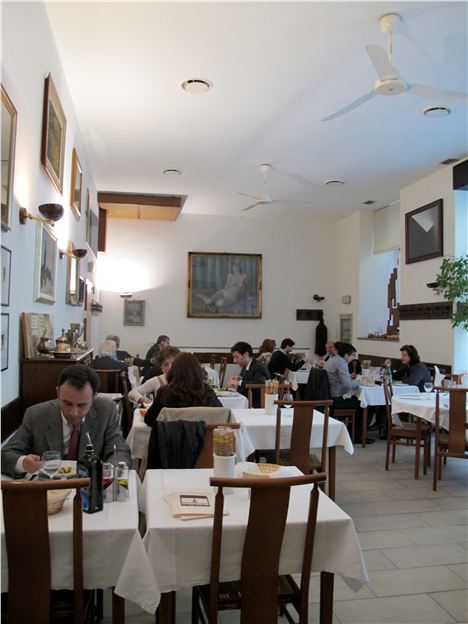 Antica Osteria Milanese – traditional simple dining in the city
Antica Osteria Milanese – traditional simple dining in the city
4 Da Giacomo and Antica Osteria Milanese restaurants
Feeling peckish now? Milan is certainly a city where you can splash the cash to eat well in a variety of styles. Here are two affordable, authentic places, the first a discreet magnet for the fashion crowd, the second a simple lunch place. Da Giacomo, an unremarkable trattoria from the outside but bright and stylish inside serving Med cuisine, is one of the city’s most exclusive places. Think a Milan Ivy. Easier to get into is the Antica Osteria Milanese, all bare boards, plain tables, flamboyant art and jazz memorabilia. The food’s standard North Italian fare – tagliatelle with ragu, steaks etc, but the wines are good value, particularly a local estate-bottled Bonarda red.
Da Giacomo, Via P Sottocorno 6
Antica Osteria Milanese, Via Camperio,12 Milano
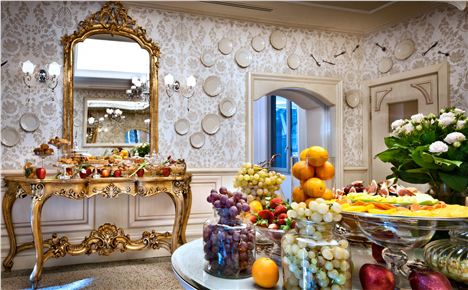 Chateau Monfort – sweet treats
Chateau Monfort – sweet treats
5 Aperitivi – sip and graze
Peckish again? Early evening in Milan and everyone finds space for an aperitivo. This is more than just a preparatory drink, in fact drink is quite secondary – it’s a way of life involving often quite elaborate nibbles in swish bars and hotels. Prosciutto-topped crostini, hot pasta might feature.
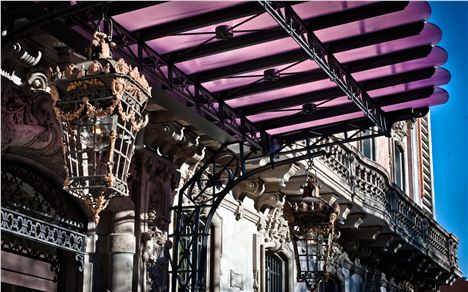 Chateau_Monfort – its breathtaking entrance facade
Chateau_Monfort – its breathtaking entrance facade
6 Chateau Monfort – a hotel of luxury and fantasy
We gorged ourselves on the aperitivo in the Mezzanotte Lounge of our hotel, Milan’s latest five-star. The Monfort describes itself as an “Urban Chateau” – hence the Frenchification of Corso Monforte, the nearby main drag to Piazza San Babila and the fashion district. Paolo Mezzanotte was its early 20th century art nouveau-inspired architect, but it has been expensively transformed in a playful neo-romanesque style with owl, butterfly, petal and rabbit motifs running riot and waiters dressed like opera extras. Superior rooms aren’t vast but exceedingly comfortable.
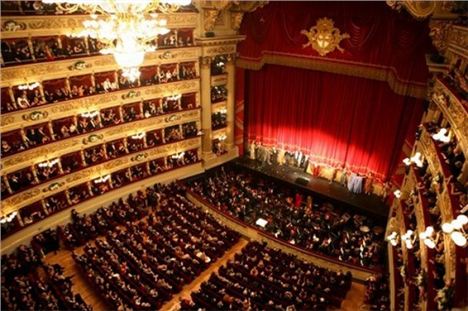 La Scala – gilt and crimson theatrical extravaganza
La Scala – gilt and crimson theatrical extravaganza
 Grand Hotel et de Milan, a hotel shrine to opera
Grand Hotel et de Milan, a hotel shrine to opera
7 La Scala and the Grand Hotel et de Milan
The Monfort is competing with traditional hotels, bulfging with historical resonance such as the Principe di Savoia in the Piazza della Republica and the gorgeous Grand Hotel et de Milan (www.grandhoteletdemilan.it). The latter’s suites are named after illustrious formeer guest such as Maria Callas and Giuseppe Verdi (the great composer died here). If you can’t afford to stay, it might be worth popping in for a drink or booking dinner in the cosy restaurant full of opera memorabilia. The soundtrack? Arias and duets, of course. It will certainly be cheaper than buying tickets for the nearby La Scala. Prices are stratospheric and for the season’s opening night you have to dress up to match the 18th century gilt and crimson of the world’s most famous concert hall. For La Scala Museum opening times visit www.teatrolascala.org.
8 Power statements – Castello Sforzesco, the San Siro and the Train Station
The 14th century Sforza Castle is an unlikely fairy tale erection in the north west of the city that survived severe damage in the war. Inside are 12 museums, notably the Pinacoteca del Castello Sforzesco with an art collection including Michelangelo’s last sculpture, the Rondanini Pieta, a Mantegna and a da Vinci manuscript. Further out is the space-age San Siro football stadium, home to Inter and AC Milan (museum and tour 12.50 euros). My favourite scary building, though, is Milano Centrale. This 1931 edifice – 25 years in the building with much architectural enhancement by Mussolini – is the embodiment of the Fascist ethos. Still Il Duce did make the trains run on time.
 The Last Supper – Leonardo's fading masterpiece
The Last Supper – Leonardo's fading masterpiece
9 Feast your eyes on The Last Supper
The Pinacoteca Brera and Ambrosiana and galleries may be home to fabulous Renaissance collections, from Titian to Caravaggio, but Milan’s greatest treasure lies in the UNESCO World Heritage site Church of Santa Maria delle Grazie. La Cenacola (The Last Supper) by Leonardo da Vinci is perilously fragile because of Leonardo’s experimental techniques and years of abuse, but most visitors to Milan feel the need for their 15 minutes in front of it. After booking four weeks or more in advance. I neglected to.
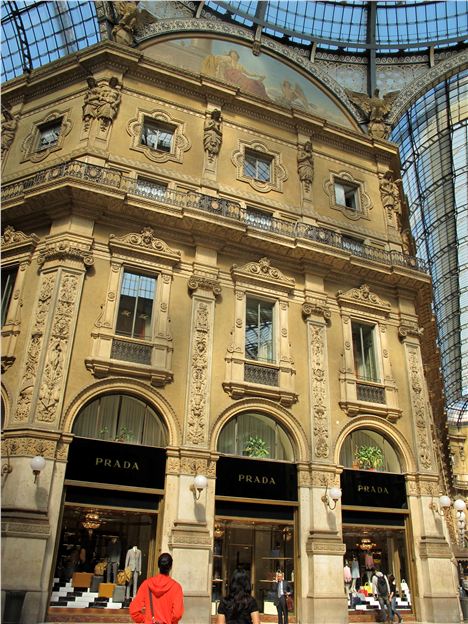 Prada – the original shop under the Galeria dome
Prada – the original shop under the Galeria dome
10 For style victims – Galleria Vittorio Emanuele II and the Quadrilate d’Oro
Inside the Galleria Vittorio Emanuele II, also known as Il Salotto di Milano (Milan's living room), I for one wasn’t worshipping at the shrine of the first Prada shop. But I did grind my heel into the testicles of the mosaic bull under the great glass dome. It’s to bring luck. The architect of this four-storey masterpiece of arching glass and cast iron didn’t have much. He plummeted to his death from it just before it was completed in 1877. The rest of MIlan seems to be designer shopping itself to death around the Monte Napo (via Monte Napoleone) and the Quadrilate d’Oro (Golden Quarter).
Fact file
Neil Sowerby stayed at the Chateau de Monfort. Five star luxury. 77 rooms, including three junior suites and five suites. Innovative restaurant. Spa to follow late summer 2012. For rates visit the www.hotelchateaumonfort. Part of the Planetaria Hotel Group: www.planetariahotels.com.
Images of the Chateau de Monfort in Gallery below
Monarch Airlines fly direct from Manchester to Milan, starting at £39 one way. For full details visit www.monarch.co.uk.
To save £10 on return flights to Italy visit http://www.planetconfidential.co.uk/Abroad/Spring-In-Italy






